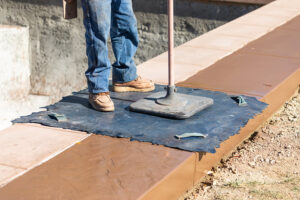Concrete Contractors have several ways to repair cracked and broken stamped concrete. Surface tears are more common during certain weather and temperature conditions. A low-solids acrylic sealer can be applied to ease the pain and bring back the color. A walk-behind sander or a buffing machine can be used to remove the rough edges. Although this method may be expensive and time-consuming, the results will last a lifetime. Here are a few ways to fix your cracked or damaged concrete:

First, you must determine the type of distress on your concrete. If the distress is severe and requires patching, you may opt for a textured surface. This type of repair is also more affordable than other forms of repairing cracked or damaged concrete. The best way to do this is by using a paint spray. Simply use a small amount of paint on a rag to cover the discoloration and then apply the color.
After choosing the color of your new concrete, you need to match it with the old one. There are many coloring agents on the market. The best ones to use are water-based metallic oxide pigments. Once you’ve chosen the color and texture of your repair concrete, you must seal it to protect the surface from oil and improve adhesion. You should also perform this task in temperatures that range from 50 degrees to 90 degrees, as it could cause cracks or deterioration of the concrete.
If you’ve recently installed a patio or a pool, you might have noticed tiny tears in the concrete. These are often mistaken for cracks and can be difficult to detect. However, these tears are actually caused by the stamping tools used during the process. Workers push down the stamping tools, causing downward pressure on the concrete and side-to-side or outward pressure that pulls the concrete apart. Fortunately, the repair process is simple and inexpensive, but if you’re not careful, it could ruin your concrete.
If you’re not sure how to fix your damaged stamped concrete, you can contact a professional for help. They will know the exact type of repairs you need and will be able to give you an estimate of how much they’ll cost you. If you’re in a hurry, you can wait for a few days before completing the repair. When the repair is complete, you’ll need to use the same stencil again to cover the entire area.
Using a water-based concrete sealer is an excellent way to restore your cracked concrete. A sealer will protect the concrete from oils and prevent it from staining and peeling. To avoid the need for costly repairs, be sure to use a high-quality product to maintain your concrete. It’s also important to remember that sealing is essential for protecting your investment. If your stamped-concrete repair needs to be waterproofed, you can apply a waterproof barrier on the damaged area.
It is very important to match the color of the new and repaired concrete with the original color of the original concrete. A variety of coloring agents are available in the market. Try using water-based metallic oxide pigments for this purpose. Ensure the sealing of the concrete before you start any repair work. You must be sure to keep the temperature above freezing during the repairs so that the color won’t change. Once the job is done, it should be ready to use in no time.
It is vital to match the color of the new and repaired concrete with the existing one. The repair needs to be done carefully and the patch should match the original concrete color. The patching material should be of the same color as the original concrete. The color should match the surrounding area of the concrete. The color should be the same as the original. Afterward, you can seal the patched concrete. This way, you can get a more uniform look.
When it comes to stamped concrete, you must ensure that the repaired area retains the original pattern. In addition, it is important to make sure the repair material blends with the existing color of the concrete. To achieve this, you must remove any loose particles and clean the area thoroughly with soapy water. Then, you should use a sealant to protect the repair. This will prevent any further damage and preserve the integrity of the installation.
